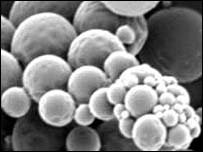The first nanobots: small cells containing anti-cancer drugs were successfully injected and performed as expected in mice. Hope for melanoma and certain types of lung cancer, but only in a decade or two
Avi Blizovsky

Pictured: nanoparticles filled with chemotherapeutic agents
A nanocell that could penetrate a tumor, shut off its blood supply and deliver a lethal dose of anti-cancer toxins was recently developed. The double healing method, packed in a tiny double cell, does not harm healthy cells. It has been shown to be safe against melanoma and certain types of lung cancer in mice.
Details of the new technique, developed by the California Institute of Technology, were published this weekend in the journal Nature.
The idea of using nanoparticles as a kind of "therapeutic Trojan horses" is a completely new idea. The technique combines two methods of fighting cancer - poisoning the tumor cells and cutting off the blood supply to the tumor.
So far, the dual method cannot be used because the chemotherapy cannot reach the cancer if the supply line - that is, the blood vessels - are blocked. Also, the drug is required to arrive at different times - the cycle of stopping the blood and the cycle of introducing the drug.
The MIT team attacked the problem by creating nano cells that resemble a balloon within a balloon. The researchers loaded the outer membrane of the nanocell with anti-angiogenic drugs (which block blood flow) and the inner balloon with chemotherapeutic agents (the drugs in the amount appropriate for a single cell). They also created a surface chemistry that allows the nanocell to avoid destruction by the body's immune system.
The nanocell is so small that it penetrates through the blood vessels of the tumor, but is too large to pass through normal blood vessels. While it is inside the tumor, the outer membrane breaks down and releases a medicine to stop the blood flow. The blood vessels that feed the tumor collapse, and they trap the charged nanoparticles inside the tumor, where they slowly release the chemotherapy drug.
Experiments in mice showed that nano-cells were able to shrink the tumor, stop the appearance of new blood vessels, and prevent damage to neighboring healthy tissues in a more effective way than all other cancer treatments.
Eight out of ten mice treated with nanocells survived for more than 65 days. Mice treated with the best chemotherapy measures survived only 30 days, while animals with cancer that were not treated died on average within 20 days.
Also, the fact that the nano cells are effective in cases of melanoma and lung cancer, indicates that it is necessary to change something in the design to fight other types of cancer.
An elegant system
The leading researcher, Ram Sasisekharan: "The model allows us to rationally and systematically evaluate the combination of the drugs and their charging mechanism. It's not going to stop here. We want to continue developing the new concept." Dr. Yehuda Folkman from Children's Hospital in Boston, says: "This is an elegant technique for attacking the two main components of the tumor - its vascular system and the cancer cells."
Henry Scowcroft from Cancer Research UK: "This is a lovely approach to curing cancer that seems to pay off in animal models of these diseases." The idea of using nanoparticles as a kind of therapeutic Trojan horse and attacking the cancer from the inside is a new idea. Although the concept is only the beginning of a long way until it becomes a routine treatment for cancer patients, these initial results look very promising."
For news at the BBC
They know nano robots
https://www.hayadan.org.il/BuildaGate4/general2/data_card.php?Cat=~~~226600840~~~175&SiteName=hayadan
